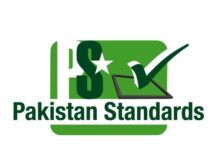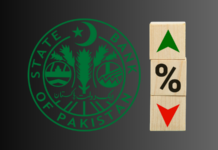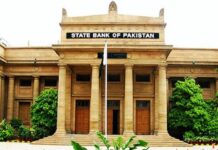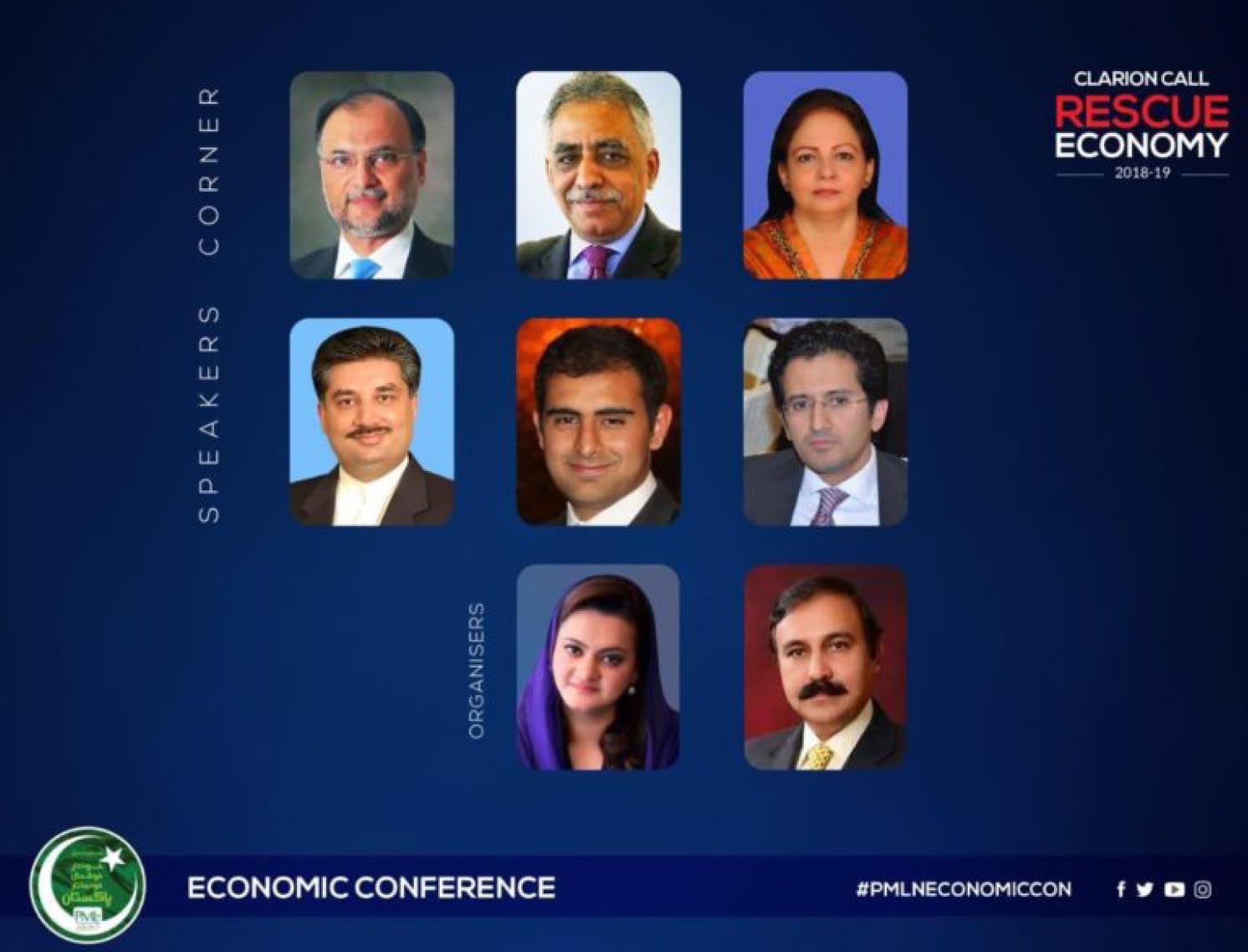Let us end the year with a bang, thought Pakistan Muslim League Nawaz (PML-N), over something that everyone can remember. Somehow, the PML-N thought a dry, technical and difficult to understand analysis of the economy was the best way to achieve that goal.
Excitedly titled “PML-N Economic Conference” – no, really – the conference was held on December 17 and led by the party’s general secretary Ahsan Iqbal. It was also attended by PML-N’s economic advisory council members, such as Muhammad Zubair, former chairman of the board of investment, Khurram Dastgir, former minister of commerce, and economist Dr Ayesha Pasha.
Meanwhile, Marriyum Aurangzeb was doing her best tweeting the conference for media attention. That, she definitely received, as she then called on Prime Minister Imran Khan to rebut the white paper released at the conference “instead of hurling slurs, threats and insults”. In response Dr Firdous Ashiq Awan lashed out and accused PML-N of “shedding crocodile tears”.
And then, after decent press coverage, the paper was forgotten, because the very person in charge of that conference, Ahsan Iqbal, was then arrested by the National Accountability Bureau (NAB) a week later over corruption charges, and the conversation changed again.
So you are probably asking: why is Profit even bringing up this paper? (Do not worry, Profit’s managing editor wondered the same). Surely there are bigger fish to fry?
There are two reasons for this.
For one, the actual contents of this paper, while interesting, are not as important as what this paper represents. For once, the conversation between political parties is not about ideology or establishment sponsorship or the army versus everyone else (disclaimer: incredibly important conversations to be had in Pakistan, no doubt), but instead is about… the state of the current reserves? The Pubic Sector Development Program (PSDP) spending?
The take down that PML-N chose to go with, that it wanted broadcast, is basically a reflection of how in the last two years, conversations about the economy, or the International Monetary Fund (IMF), or taxes, have actually permeated national consciousness in society in a way that it had not before.
And that is important because whether you agree or disagree with the premise of the paper, we are all engaging with it at a level unseen before. This is good news for financial journalism, good news for our democracy, and good news for a more informed public.
Second: the paper has a whole two slides dedicated to calling the ruling Pakistan Tehrik-e-Insaf (PTI) a fascist party. This cannot be stressed enough. Outside of the liberal twitter chatter, or those in the Pakistani far-left, (and those two camps are distinct), when have you heard of a national party being openly called fascist by an opposition party in Pakistan?
Almost all news coverage of the white paper declined to mention how strange – or even frank and bold – that is. And that section, too, deserves examination.
The economy
The white paper, grandly titled “Clarion Call, Rescue Economy”, is less of a paper, and more like 11 slides of a Powerpoint presentation. While a significant amount is spent discussing the PTI’s failure with regard to India, the bulk is spent discussing the problem with Imran Khan’s economy.
As far as PML-N is concerned, the “Imran Khan government inflicted on 210 million Pakistanis the worst era of governance in Pakistan’s history; marked by catastrophic mismanagement in national security and economic policy; and by condemnable degradation in human development and in constitutional rights of Pakistani citizens.”
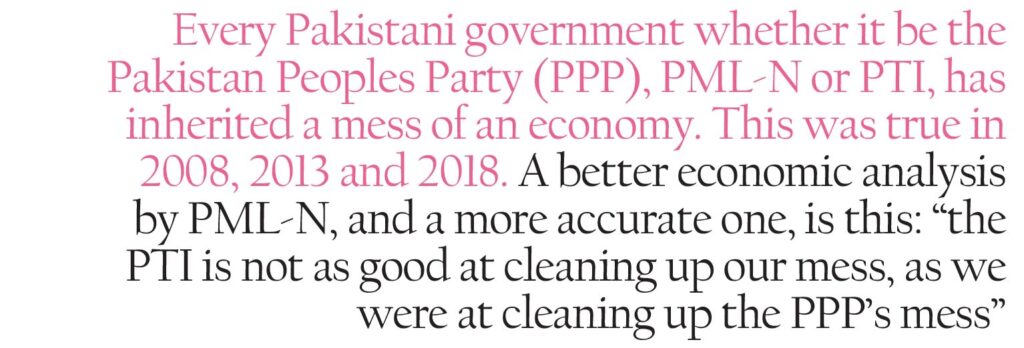
As for what they are specifically upset about: there are a couple of salient points. First, the size of the economy, as measured by gross domestic product (GDP). According to the paper, Pakistan’s GDP at the completion of PML-N tenure in 2018 was $315 billion, while Pakistan’s GDP at completion of the first year of Imran Khan’s government is $275 billion.
As per the paper, the “GDP growth rate plunged to less than 3% under IK compared to 5.8% growth achieved in the last year of PML-N.”
Secondly, inflation has risen from 3.9% in June 2018, to 12.7% in November 2019. PML-N also claimed it had one of the lowest inflation rates at 2.9% in the fiscal year ending June 30, 2016. According to the paper, this high cost of inflation has “massively contributed to the nightmare of the masses”.
And worryingly, that high inflation will affect poverty rates in the country. “This has resulted in pushing more than 8 milion Pakistanis below the poverty line within 16 months,” the paper claims. According to PML-N, this means that the national poverty rate will go to 40% in June 2020.
Third, as per PML-N, the PTI government posted the highest ever fiscal deficit, at 8.9%. “This is the highest that Pakistan has seen in the last 40 years.”
The PML-N paper writers also managed to work in a good jab directed at the Prime Minister’s Finance Advisor and de facto finance minister Hafeez Shaikh, noting the prices of tomatoes twice: “tomatoes have [risen] by an unbelievable 437%”, and “Nothing was more hilarious than the finance advisor’s statement regarding the price of tomatoes when he claimed the price be Rs 17 as against market prices of Rs 350.”
Tomatoes aside, when you look at the numbers presented this way, much of the above information is correct.
But the problem is that the PML-N is comparing its final years to PTI’s first years, forgetting a cardinal fact: every Pakistani government whether it be the Pakistan Peoples Party (PPP), PML-N or PTI, has inherited a mess of an economy. This was true in 2008, 2013 and 2018. It is sad but in Pakistan you can not actually judge any party’s economic policy. Instead, you have to judge how efficiently and quickly was the party able to reverse the economic damage done previously.
A better economic analysis by PML-N, and a more accurate one, is this: “the PTI is not as good at cleaning up our mess, as we were at cleaning up the PPP’s mess”.
On that account, PML-N actually did really well. After winning the general election in 2013, PML-N had to figure out what to do with PPP’s mess. Pakistan’s economic growth was around 3.5%, and forex reserves were around $6.5 billion, their lowest level in 10 years. PML-N policies were able to turn that around.
First, they did exactly what PTI did, which is go to the IMF, for a three-year $6.68 billion programme to help the economy. Secondly, they got the ball rolling on the China-Pakistan Economic Corridor (CPEC), which led to an increase in spending on development projects.
Unfortunately, that is where the positive story ends. As everyone now knows, the PML-N was betting on a consumption-led growth model. This led to an increase in imports, but not much increase in exports since the PML-N was not focused on manufacturing.
Most of the low inflation was also helped by very low global oil prices that the PML-N passed on to the consumer. Even the low interest rates that PML-N is boasting about did not lead to a stimulation of the economy as expected, and there was little investment from the private sector.
And the worst, and this reporter’s personal pet peeve, was the absurdly pegged rupee.
One would assume that the PML-N paper authors would keep the conversation around the numbers mentioned previously and not broach the topic of rupee: yet, bravely/stupidly, they called the devaluation of the rupee from Rs115 to Rs159 a ‘major blunder’.
“Devaluation failed disastrously; exports actually fell, boosted inflation and harmed industry using imported inputs.” Later, they wrote: “Despite a massive 40% devaluation of Pak Rupee, exports decreased to minus -1.3% under IK, compared to positive 12.8% growth achieved in the last year.”
The rupee’s inability to devalue is one of the major reasons for the PML-N mess that PTI is now attempting to fix.
The PML-N in their paper actually answers their own created problem: “The ideal way to improve current account deficit is to increase your exports which unfortunately has not been the case.” Yes, exactly! Devaluation combined with a robust manufacturing sector: unfortunately on that last one, the PTI has also failed to deliver.
Facism
One cannot stress enough how absolutely wild it is that this word is being used in Pakistani political space. For one, we live in a world where our next door neighbor’s government is engaged in policies that have been compared to outright facism (fairly or not), and generally, the world that we live in has seen a rise in right-wing governments across the world.
So, obviously, this is a loaded word. Let us first look at the textbook definition of what fascism is: “A political philosophy, movement, or regime that exalts the nation and often race, above the individual and that stands for a centralized autocratic government headed by a dictatorial leader, severe economic and social regimentation, and forcible suppression of opposition.”

If you are in the opposition, you could see PTI as a quasi-fascist party, headed by a ‘dictatorial leader’, democratically elected, but Establishment-backed, and of course, the forcible suppression of opposition.
Which is why the paper goes on to say: “Media in the first one year of Imran Khan’s government suffered near-total censorship, acknowledged and documented around the world, and repeatedly protested against by all recognised journalists bodies.”
As per the paper, channels were taken off air, interviews of PML-N politician Maryam Nawaz, former Finance Minister Ishaq Dar, and former President Asif Ali Zardari were blocked. Maryam Nawaz’s rallies were also blocked from coverage.
And more importantly, “trolling at the behest of PTI peaked and threats, intimidation and abuse of honest critics quadrupled.”
Why are we at Profit highlighting this? Firstly, because as a publication, it is in our interest to be able to comment openly on the affairs of the country, financial or otherwise. Secondly, whether or not you agree with PML-N on their version of press freedom, it is a fact that press in Pakistan does have pressures exerted on it by both the Establishment and the government.
And most importantly, a climate of uncertainty, or a climate of perceived injustice or perceived media black out, is not good for an economy.
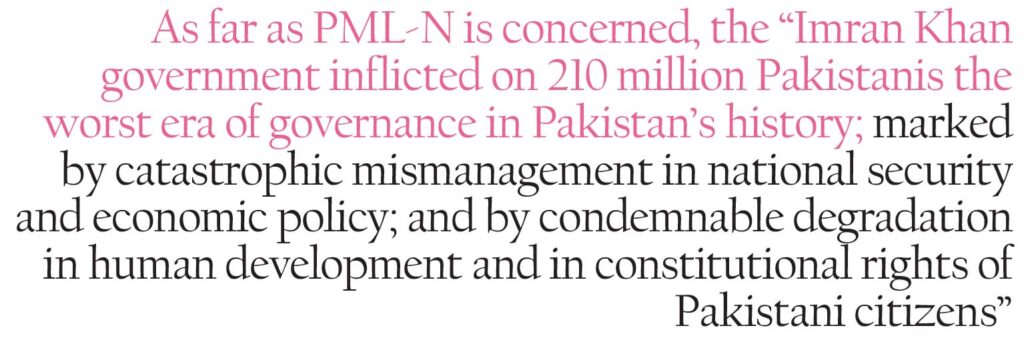
Discussion of the economy is not just limited to watching the deficit number go up and down. It is also about, for instance, talking openly about tax evaders, or what is wrong with the abiana tax in our irrigation system, or what is up with our sugar mafia. And that depends on creating an environment of free speech – whether that is PTI or PMl-N or PPP.
If a PTI troll, in this case, is holding on steadfastly to an alternate version of an economic narrative, then that is not good over all for the economy or the public.
End
So where does that leave us? Well, as mentioned before, less than a week after the release of this white paper, Ahsan Iqbal was arrested by the NAB for alleged corruption in a sports complex.
If you are on the side of the PTI, it is just another day in Naya Pakistan, where corrupt politicians are finally being held accountable by the government. If you are on the side of the PML-N, it is just another day in Naya Pakistan, where perfectly reasonable politicians are being hounded by a fascist and Establishment-backed administration.
And in the midst of this, the economy is being as a punching bag, where both sides are hoping to outdo one another on whose deficit is smaller.
In reality, the two conversations of the ‘economy’ and ‘political freedom’ go hand in hand. Many often divorce the two topics in Pakistan, to the detriment of both. And that is why engaging with even white papers, no matter how obvious, or repetitive, is important for every political party out there, and for every citizen reading.


